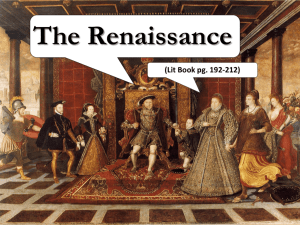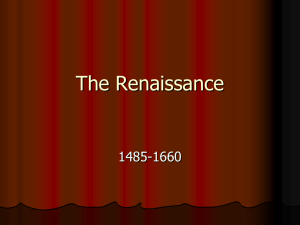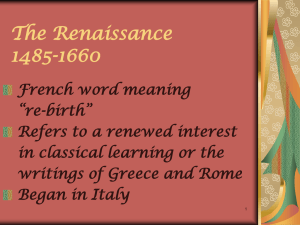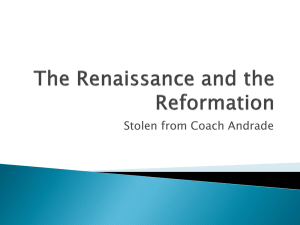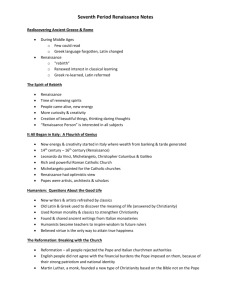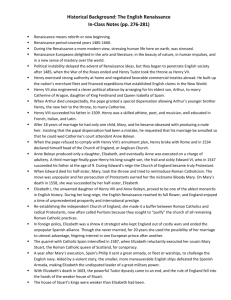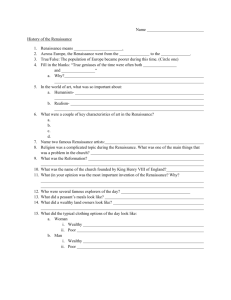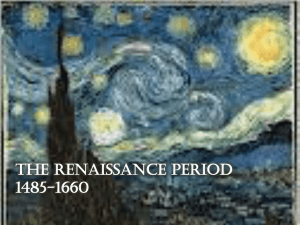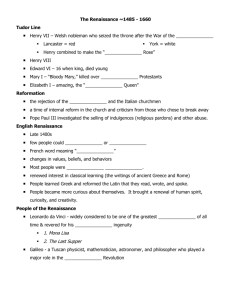The Renaissance
advertisement
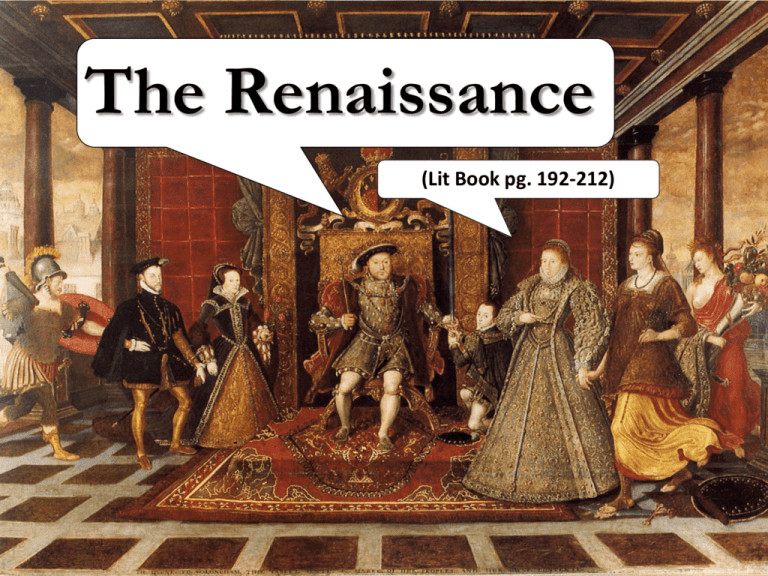
The Renaissance (Lit Book pg. 192-212) Rediscovering Ancient Greece and Rome • “Renaissance” means “rebirth,” it referred to era where old Greek and Roman classic were rediscovered, a flourishing of human spirit, curiosity, and creativity. • In old the classics, Renaissance people discovered proper Greek and Latin languages. • A Renaissance person: someone interested and active in all aspects of life (humanities, art, science, math, such as Leonardo da Vinci). It All Began in Italy: A Flourish of Genius • Italy gained influence and wealth from trading with Asia and the Mediterranean. • The main religion in Europe at this time was Roman Catholicism. • The church and its popes added to artistic endeavors by sponsoring/commissioning great artists of the day. • Many Renaissance artists had an optimistic view of humanity; they believed that individual human beings in paintings were noble, near perfection. Humanism: Questions about the Good Life • Humanists looked to the classics and Christianity for inspiration. • Humanists asked 3 questions about life: 1. What is a human being? 2. What is a good life? 3. How do I lead a good life? • Humanists found no conflict between the ideas of the Church and ancient Romans; they sought to combine the two. • Humanists used combined philosophies to teach about how to live, how to rule The New Technology: A Flood of Print • Johannes Gutenberg invented the printing press in about 1455 • This invention changed society by increasing the speed, availability of printed materials; the Bible was most popular and widespread In Short, the Renaissance involved: • People expanding education through Greek and Roman classics • The spread of humanism, attention to life here and now as well as eternal life for humanity • The printing press, spread of scholarly Latin • A growing richer merchant class with wealth from Age of Exploration to challenge the elite Two Friends—Two Humanists • Desiderius Erasmus (1466?-1536) was the best known Renaissance humanist, a monk who lived in the world, traveled, taught Greek, loved classics; he was loyal to the Church, yet saw Church's shortcomings • Thomas More was British lawyer who rose in government stature, humanist, wrote Utopia in 1516 (analyzing social, economic, penal, moral problems within Great Britain and a narrative describing "utopia“) • A “utopia” is an impractical perfect image of society • More’s affect on the world included being admired for his ethics; he is admirable to modern lawyers The Reformation: Breaking with the Church • All church reformers rejected authority of Pope and Italian churchmen. • The final break with the Roman Church occur in England in 1533. • The British resented rule by the Vatican because of patriotism/national identity, church taxes, and protestant ideas. • Martin Luther contributed to the Reformation because he founded principles of selfinterpretation of Bible, rejected Pope, public movement towards new denomination. King versus Pope: All for an Heir • Trouble between the Church and King Henry VIII began when Henry's marriage to Catherine required a special dispensation (for marrying his dead brother’s wife). • Henry had two motives for getting rid of Catherine: 1. She was old and plain and couldn't bear a son. 2. Henry had his mistress Anne Boleyn, whom he wanted to marry. • Henry responded to the Pope’s refusal by formally breaking away from Catholic Church and Pope and establishing state Church of England, with king and Archbishop of Canterbury as heads. • When Thomas More when he stood up to Henry he was beheaded. • This event began the Protestant Reformation because a new church had broken with Catholic Church; it opened the way for other Protestant denominations in England. Divorced. Divorced. 4 1 Catherine of Aragon Anne of Cleves Beheaded. Beheaded. 5 Anne Boleyn Catherine Howard Died. Survived!! 3 6 Jane Seymour Catherine Parr Henry VIII: Renaissance Man and Executioner • The five Tudor rulers of England were Henry VII, Henry VIII, Edward VI, Mary I, and Elizabeth I. • Henry is considered to be a “Renaissance Man” because he was interested poetry, music, art, architecture, athletics, hunting, and humanism. The Boy King and Bloody Mary • Henry’s surviving children (in order of birth): Mary I, Elizabeth I, and Edward VI. • Edward was intelligent but sick and weak; he ruled in name only (died at age 15). • Mary was totally opposite from her father Henry. She was a devout Catholic and married Spanish king. She allied herself again with the Pope and persecuted protestants. (1547-1553) (1553-1558) Elizabeth: The Virgin Queen • Elizabeth’s first task as queen was restore law and order by reestablishing Church of England. • She kept peace with Spain by pretending to plan on marrying her sister's widower. • Elizabeth never married because she would be stronger as an independent queen, she would not be subservient to a husband. • Elizabeth’s cousin, Mary Queen of Scots, was next in line for the throne and plotted to kill Elizabeth. • Elizabeth responded to this plot by ordering her cousin’s house arrest and eventual beheading. The Spanish Armada Sinks: A Turning Point in History • King Phillip of Spain used the execution of Mary Queen of Scots as an excuse to attack. • In 1588, the English Royal Navy defeated the Spanish Armada. Elizabeth I (reigned 1558-1603) 1546 1558 1575 A Flood of Literature • Elizabeth became symbol of peace, security, and prosperity, and many types of literature flourished during her reign; she was represented mythologically in poetry, drama, fiction. Decline of the Renaissance • James I, son of Mary Queen of Scots (and Elizabeth’s second cousin) succeeded her on the throne . • James, however, lacked Elizabeth’s strong character: he was bad with money, awkward, and a foreigner. • The new king’s biggest accomplishment was the King James Bible. • James was followed by Charles I (who was beheaded by his subjects in 1649), then Charles II. • After Elizabeth died, the political climate was characterized by weak leadership, eroded Renaissance values, and the end of English Renaissance. • The last great writer of the Renaissance was John Milton. The Family of Henry VIII Elizabeth I Henry VIII Philip of Spain “War” Mary I Edward VI “Peace” & “Plenty”
